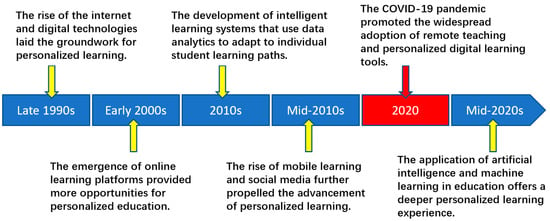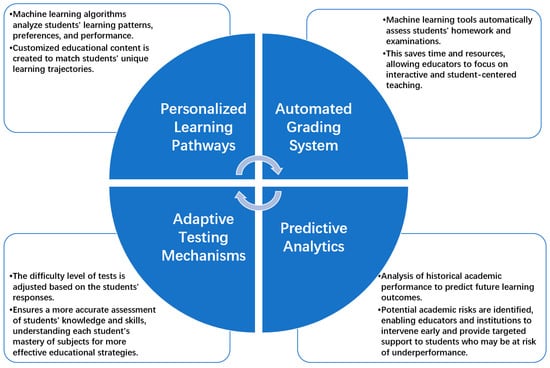You're using an outdated browser. Please upgrade to a modern browser for the best experience.
Please note this is a comparison between Version 1 by Seong-Yoon Shin and Version 2 by Rita Xu.
A novel approach named the Dynamic Feedback-Driven Learning Optimization Framework (DFDLOF), aimed at personalizing educational pathways through machine learning technology.
- machine learning
- personalized education
- adaptive learning systems
1. Introduction
1.1. Background of Personalized Education in the Digital Era
In the digital era, personalized education has become pivotal in transforming learning paradigms [1]. It transcends traditional, one-size-fits-all approaches, aiming instead to tailor the educational experience to individual learners’ needs, abilities, and interests. This shift is driven by the increasing recognition that learners are diverse regarding their academic abilities, learning styles, and motivational drivers. Digital technologies have catalyzed this transition, offering unprecedented opportunities for customized learning experiences [2]. Digital platforms, replete with rich, interactive content, enable educators to craft individualized learning pathways. The data-driven nature of these platforms allows for real-time adjustments and a deep understanding of learner engagement and progress [3]. Thus, personalized education in the digital era is not merely an academic concept but a practical approach to nurturing diverse talents and abilities in an increasingly complex and information-rich world.
To further illustrate this transformation, refer to the timeline depicted below. Figure 1 presents a chronological overview of the pivotal developments in personalized education through the digital era. It traces the evolution from the late 1990s, with the rise of the internet, to the mid-2020s, when artificial intelligence and machine learning began to deeply inform educational practices.

Figure 1. Timeline of key milestones in the evolution of personalized education in the digital era.
1.2. The Evolution and Impact of Machine Learning in Education
The use of machine learning in education is a milestone in personalizing education [4]. Historically, education methods were most static and reactive because of logistical constraints and resource limitations. However, machine learning adds a dynamic and proactive touch. It uses big data to reveal learning patterns, forecast results, and customize the educational material and user experience [5]. Machine learning has a profound effect on helping educators develop more adaptive curricula and better understand learner needs at a more sophisticated level. Machine learning applications are broadening in schools, from grading to tutoring to e-school news. They usher in a new epoch in education within which learning ceases to be a transfer of knowledge and becomes an inspiring discussion for every student, thus making education democratic.
2. Applications of Machine Learning in Educational Settings
Machine learning (ML) has emerged as a cornerstone technology in contemporary educational settings, reshaping the landscape of learning and teaching methodologies [6][8]. The efficacy of ML lies in its ability to analyze extensive datasets, extracting patterns and insights that are imperceptible to the human eye [7][9]. This capability finds its application in several areas within the educational sphere. One of the primary areas is the development of personalized learning environments [8][10]. Here, ML algorithms assess individual student’s learning patterns, preferences, and performances, enabling the creation of customized educational content that matches their unique learning trajectories. Another significant application of ML in education is the automation of administrative tasks [9][11]. Tasks such as grading and assessment traditionally consume considerable time, and resources are now being streamlined through ML algorithms. This enhances efficiency and gives educators more time to focus on interactive and student-centered teaching. ML has revolutionized the domain of predictive analytics in education [10][12]. By analyzing past student performance data, ML algorithms can predict future learning outcomes and identify potential academic risks. This foresight enables educators and institutions to intervene early, providing targeted support to students who might be at risk of underperforming [11][13]. ML contributes to the evolution of adaptive testing mechanisms. These systems adjust the difficulty level of tests based on the student’s responses, ensuring a more accurate assessment of their knowledge and skills. Such adaptive tests are crucial in understanding each student’s mastery of subjects, allowing for more effective and targeted educational strategies [12][14]. Integrating ML in educational tools has facilitated more engaging and interactive learning experiences. Gamified learning environments, interactive simulations, and virtual labs powered by ML algorithms offer students an immersive and hands-on learning experience, significantly enhancing their engagement and knowledge retention [13][15]. In essence, machine learning applications in educational settings are vast and varied, each contributing to a more effective, efficient, and personalized learning experience. As ML technology continues to advance, its role in shaping the future of education is both significant and indispensable. In the context of the aforementioned applications of ML in education, Figure 2 visually encapsulates the diverse and transformative roles that ML plays within the educational ecosystem. The diagram illustrates the flow from data processing to tailored educational interventions, encapsulating the multifaceted impact of machine learning on the educational experience.
Figure 2. Diverse applications of machine learning in educational settings.
